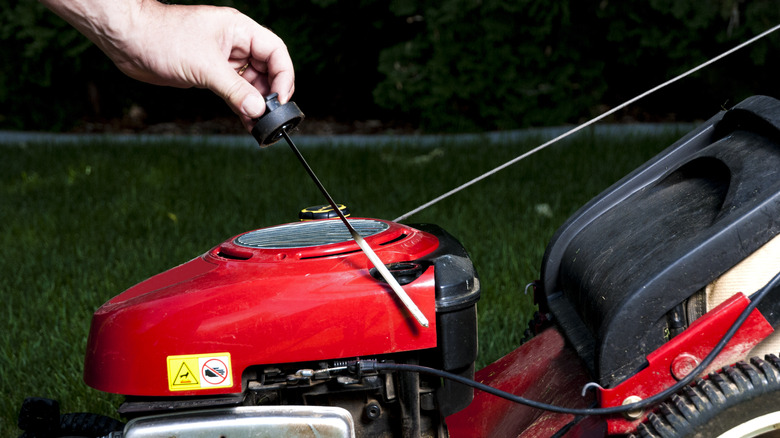Change Oil In Push Mower

I. Introduction
A well-maintained push mower is a homeowner's secret weapon for a pristine lawn. Regular oil changes are vital for ensuring your mower operates smoothly, efficiently, and enjoys a longer lifespan. Just like a car engine, a push mower's engine relies on clean oil to lubricate moving parts, minimize friction, and dissipate heat.
A. The Importance of Regular Oil Changes
Neglecting oil changes can have detrimental consequences. Old oil becomes contaminated with dirt, debris, and metal shavings produced by engine wear. This sludge thickens the oil, hindering its ability to lubricate effectively. Consequently, increased friction accelerates engine wear, reduces power output, and ultimately leads to costly repairs or even engine failure.
B. Signs Your Push Mower Needs an Oil Change
Several telltale signs indicate the need for an oil change. If your mower struggles to start, runs rough, or emits excessive blue smoke, these could be symptoms of dirty or low oil. Additionally, a noticeable decline in cutting power or overheating after short mowing sessions can point towards oil-related issues.
II. Essential Tools and Materials
Before diving into the oil change process, ensure you have the necessary tools and materials on hand.
A. Safety Gear
Safety is paramount. Wear protective gloves to shield your hands from hot oil and a dust mask to avoid inhaling fumes during the draining process. Consider safety glasses for additional protection from splashes.
B. Oil Disposal and Replacement
Consult your mower's owner's manual to determine the recommended oil type and viscosity. Most push mowers utilize SAE 30 motor oil, but specific requirements may vary. Equally important is the proper disposal of used oil. Never pour used oil down the drain or onto the ground. Many auto parts stores and service stations accept used oil for recycling.
C. Additional Tools
- Drain pan: To collect the used oil
- Funnel: To facilitate pouring new oil into the engine
- Rags: For wiping up spills
- Socket wrench (optional): Depending on your mower's design, you might need a socket wrench to remove the oil filter (if applicable).
III. Step-by-Step Guide to Changing Push Mower Oil
A. Preparing for the Oil Change
- Warm Up the Engine: Run the mower for a few minutes to warm up the oil, making it drain more easily.
- Level the Mower: Park your mower on a level surface to prevent oil spills.
- Disconnect the Spark Plug: Locate the spark plug wire and disconnect it from the spark plug. This prevents accidental engine starts during the oil change process.
B. Draining the Old Oil
- Locate the Drain Plug: Refer to your owner's manual for the exact location of the drain plug. It's typically positioned near the base of the engine.
- Place the Drain Pan: Position the drain pan directly beneath the drain plug to collect the used oil.
- Unscrew the Drain Plug: Carefully use a wrench or your fingers (depending on the design) to loosen and remove the drain plug. Be prepared for a rush of oil; allow it to drain completely into the pan.
- Replace the Drain Plug: Once all the oil has drained, screw the drain plug back in snugly using a wrench (if applicable).
C. Replacing the Oil Filter (if applicable)
Some push mowers come equipped with replaceable oil filters. Consult your owner's manual for instructions on locating and removing the old filter, then replace it with a new one recommended by the manufacturer.
D. Adding New Oil and Checking Levels
- Locate the Oil Filler Tube: The oil filler tube is usually situated on the top of the engine, often with a dipstick attached.
- Add New Oil: Insert the funnel into the filler tube and slowly pour in the recommended amount of fresh oil, as specified in your owner's manual. Most push mowers have a dipstick with markings indicating the minimum and maximum oil levels.
- Check the Oil Level: With the engine off and the mower level, remove the dipstick, wipe it clean with a rag, and reinsert it fully. Then, pull out the dipstick again and check the oil level on the marked dipstick. The oil level should be between the minimum and maximum markings. If the oil level is low, add a small amount of oil at a time, checking the level after each addition until it reaches the proper range.
E. Post-Change Cleanup and Disposal
- Clean Up: Wipe up any spills with a rag. Ensure the oil filler cap and drain plug are securely tightened to prevent leaks.
- Used Oil Disposal: Take your used oil to a designated recycling center. Never dispose of used oil in the trash or down the drain.
IV. Conclusion
Congratulations! You've successfully completed your push mower oil change. Regularly changing your mower's oil is a simple yet crucial maintenance task that extends the life of your engine, optimizes its performance, and keeps your lawn looking its best.
Post a Comment for "Change Oil In Push Mower"